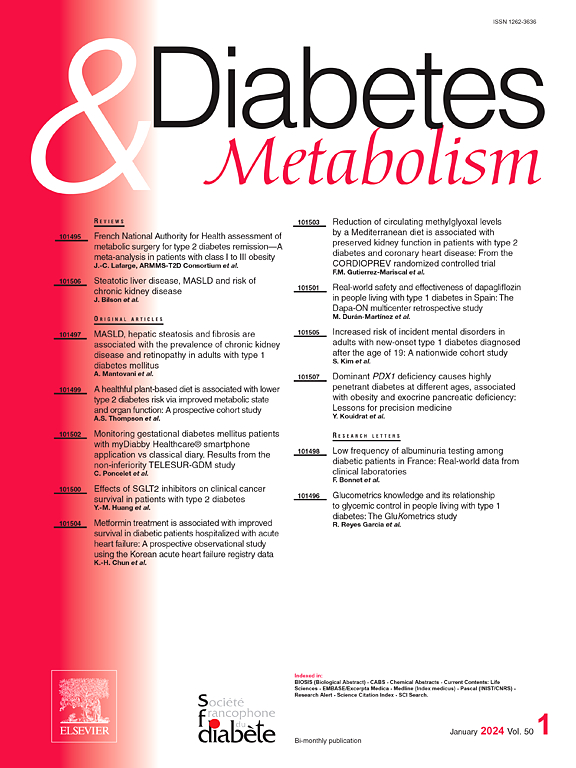皮肤自身荧光预测心血管事件:DIABAGE随访研究
IF 4.7
2区 医学
Q1 ENDOCRINOLOGY & METABOLISM
引用次数: 0
摘要
目的:。已知晚期糖基化终产物(AGEs)在1型糖尿病(T1D)并发症的病理生理中发挥作用。本研究的目的是评估皮肤自身荧光(SAF)间接评估的AGEs对T1D患者心血管事件(CVEs)发生的预测价值。方法:。我们测量了至少有10年糖尿病病史的T1D患者的基线SAF,并评估了cve的发生率。采用ROC曲线确定SAF的最佳阈值,并采用Cox比例回归评价其预测价值。结果:。该研究包括179名患者,其中53%是女性。基线时,平均年龄为47.7±15.9岁,平均糖尿病病程为26.4±12.2年。中位HbA1c为7.7%(7.3-8.7),中位LDL胆固醇为2.58 mmol/l(2.14-3.07)。24例患者34例cve,中位随访7.4年(6.85 - 7.7)。发生cve患者的中位SAF水平为2.7(2.3-3.1),无cve患者的中位SAF水平为2.1(1.8-2.6)。SAF区分有无cve的最佳阈值为2.2。未调整模型的最佳SAF阈值可以预测CVE的发生(HR 6.46),不同模型调整后的最佳SAF阈值也可以预测CVE的发生(HR 3.15-5.05)。结论:。出现cve的T1D患者的SAF水平较高。SAF阈值为2.2预测CVE的发生。如果这些结果得到证实,SAF可能是T1D患者心血管危险分层的有用标志物。本文章由计算机程序翻译,如有差异,请以英文原文为准。
Prediction of cardiovascular events by skin auto-fluorescence: the DIABAGE follow-up study
Aim
Advanced glycation end-products (AGEs) are known to play a role in the pathophysiology of type 1 diabetes (T1D) complications. The aim of this study was to assess the predictive value of AGEs indirectly evaluated by skin auto-fluorescence (SAF) on the occurrence of cardiovascular events (CVEs) in T1D.
Methods
We measured baseline SAF in T1D patients with at least 10 years history of diabetes and assessed incident CVEs. An optimum threshold of SAF was determined using ROC curve, and its predictive value was assessed by Cox proportional regression.
Results
The study included 179 patients, 53 % of whom were women. At baseline, the mean age was 47.7 ± 15.9 years, the mean duration of diabetes was 26.4 ± 12.2 years. Median HbA1c was 7.7 % (7.3–8.7) and median LDL cholesterol was 2.58 mmol/l (2.14–3.07). Median follow-up was 7.4 years (6.85 - 7.7) with 34 CVEs in 24 patients.
The median SAF level was 2.7 (2.3–3.1) in patients with incident CVEs and 2.1 (1.8–2.6) in patients without CVEs. The optimum threshold of SAF to differentiate patients with or without incident CVEs was 2.2. The occurrence of CVE was predicted by the optimum SAF threshold in the unadjusted model (HR 6.46), but also after adjustment with different models (HR 3.15–5.05).
Conclusion
SAF level is higher in people living with T1D who will present CVEs. Furthermore, SAF threshold of 2.2 predicted the occurrence of CVE. If these results are confirmed, SAF could be a useful marker in cardiovascular risk stratification in T1D.
求助全文
通过发布文献求助,成功后即可免费获取论文全文。
去求助
来源期刊

Diabetes & metabolism
医学-内分泌学与代谢
CiteScore
12.00
自引率
4.20%
发文量
86
审稿时长
13 days
期刊介绍:
A high quality scientific journal with an international readership
Official publication of the SFD, Diabetes & Metabolism, publishes high-quality papers by leading teams, forming a close link between hospital and research units. Diabetes & Metabolism is published in English language and is indexed in all major databases with its impact factor constantly progressing.
Diabetes & Metabolism contains original articles, short reports and comprehensive reviews.
 求助内容:
求助内容: 应助结果提醒方式:
应助结果提醒方式:


